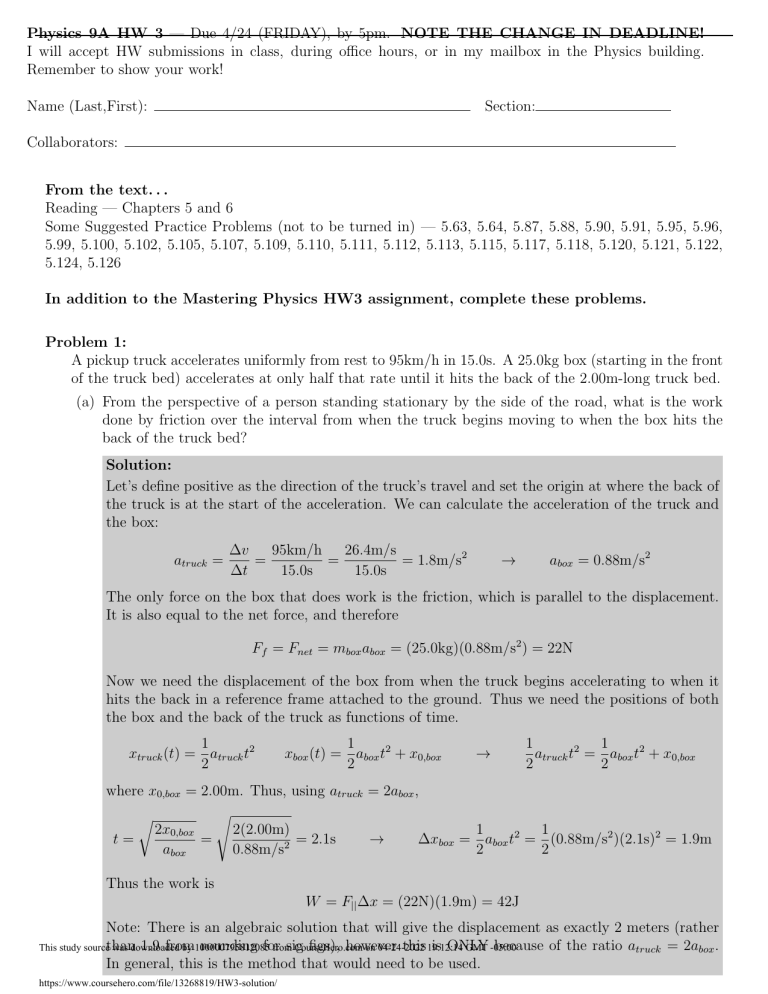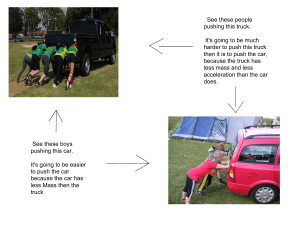
Physics 9A HW 3 — Due 4/24 (FRIDAY), by 5pm. NOTE THE CHANGE IN DEADLINE! I will accept HW submissions in class, during office hours, or in my mailbox in the Physics building. Remember to show your work! Section: Name (Last,First): Collaborators: From the text. . . Reading — Chapters 5 and 6 Some Suggested Practice Problems (not to be turned in) — 5.63, 5.64, 5.87, 5.88, 5.90, 5.91, 5.95, 5.96, 5.99, 5.100, 5.102, 5.105, 5.107, 5.109, 5.110, 5.111, 5.112, 5.113, 5.115, 5.117, 5.118, 5.120, 5.121, 5.122, 5.124, 5.126 In addition to the Mastering Physics HW3 assignment, complete these problems. Problem 1: A pickup truck accelerates uniformly from rest to 95km/h in 15.0s. A 25.0kg box (starting in the front of the truck bed) accelerates at only half that rate until it hits the back of the 2.00m-long truck bed. (a) From the perspective of a person standing stationary by the side of the road, what is the work done by friction over the interval from when the truck begins moving to when the box hits the back of the truck bed? Solution: Let’s define positive as the direction of the truck’s travel and set the origin at where the back of the truck is at the start of the acceleration. We can calculate the acceleration of the truck and the box: atruck = 95km/h 26.4m/s ∆v = = = 1.8m/s2 ∆t 15.0s 15.0s → abox = 0.88m/s2 The only force on the box that does work is the friction, which is parallel to the displacement. It is also equal to the net force, and therefore Ff = Fnet = mbox abox = (25.0kg)(0.88m/s2 ) = 22N Now we need the displacement of the box from when the truck begins accelerating to when it hits the back in a reference frame attached to the ground. Thus we need the positions of both the box and the back of the truck as functions of time. 1 xtruck (t) = atruck t2 2 1 xbox (t) = abox t2 + x0,box 2 → 1 1 atruck t2 = abox t2 + x0,box 2 2 where x0,box = 2.00m. Thus, using atruck = 2abox , s r 2x0,box 2(2.00m) 1 1 t= = → ∆xbox = abox t2 = (0.88m/s2 )(2.1s)2 = 1.9m 2 = 2.1s abox 0.88m/s 2 2 Thus the work is W = F|| ∆x = (22N)(1.9m) = 42J Note: There is an algebraic solution that will give the displacement as exactly 2 meters (rather 1.9 from rounding for sig figs), however this 19:12:14 is ONLY because of the ratio atruck = 2abox . This study sourcethan was downloaded by 100000795812085 from CourseHero.com on 04-24-2022 GMT -05:00 In general, this is the method that would need to be used. https://www.coursehero.com/file/13268819/HW3-solution/ (b) The truck continues at 95km/h for some time, and then decelerates to a stop, and the box remains in the back of the truck bed. From the perspective of a car traveling past at a constant 95km/h in the same direction that the truck was moving, what was the work done on the box in the stopping interval? What force did this work? Solution: The work done on the box in this interval changed its kinetic energy. In the given frame of reference (using the same positive direction as in (a) ) the box begins with zero velocity and ends with a velocity of -95km/h. This means that the work is 1 1 W = ∆KE = mbox ∆(v 2 ) = (25.0kg) (−26.4m/s)2 − (0m/s)2 = 8.7kJ 2 2 (note that I waited until the end to round to 2 sig figs). The friction force is again the force doing the work - without friction the box would slide to the front of the truck. (c) From the perspective of a car traveling past at a constant 95km/h in the opposite direction that the truck was moving, what was the work done on the box in the stopping interval? Solution: Similarly to (b), but now the box begins with a velocity of -190km/h and ends with a velocity of 95km/h. This means that the work is 1 1 W = ∆KE = mbox ∆(v 2 ) = (25.0kg) (26.4m/s)2 − (−52.8m/s)2 = −26kJ 2 2 Problem 2: A horizontally oriented spring is attached to a block of mass 5.00kg sitting on a rough surface with µk = 0.500. The spring (with a spring constant of 272N/m) is initially compressed 55.0cm. The block is then released. (a) Quantitatively prove that the block will pass through the equilibrium point at least once. Solution: The force on the block in the interval from the initial point (x = −0.550m), where the spring is compressed and the speed is zero, to the equilibrium point for the spring (which we will denote as x = 0), is: F = −kx − µmg The spring force is positive (recall that x is negative in this interval) and the friction force is negative. The work done on the block is therefore Z 0 1 1 W = −kx − µmg dx = − kx2 − µmgx|0xi = kx2i + µmgxi 2 2 xi Recall that xi is negative. If this work is positive, the block will have increased its speed, and therefore will be going through the spring’s equilibrium point. If it is zero, or negative, this will not be the case (instead the block will stop at or before then, respectively). We can calculate this: 1 W = (272N/m)(−0.550m)2 + (0.500)(5.00kg)(9.81m/s2 )(−0.550m) = 27.7J 2 It’s positive, so the block passes the equilibrium of the spring. (b) How far from the spring’s equilibrium point will the block first stop? This study sourceSolution: was downloaded by 100000795812085 from CourseHero.com on 04-24-2022 19:12:14 GMT -05:00 https://www.coursehero.com/file/13268819/HW3-solution/ The block will stop when its speed returns to zero. Over this interval, the friction acts in one direction (towards the block’s starting point) and the work is zero (starting and ending at zero kinetic energy). Thus Z xf 1 x −kx − µmg dx = − kx2 − µmgx|xfi = 0 W = 2 xi 1 2 1 2 2µmg 2µmg 2 2 kx + µmgxi = kxf + µmgxf → 0 = xf + xf − xi + xi 2 i 2 k k s µmg 2 µmg 2µmg 2 xf = − ± xi + xi + k k k We choose the + root because we know that the block passes through equilibrium, and so xf must be positive. We can now calculate xf µmg (0.500)(5.00kg)(9.81m/s2 ) = = 0.0902m → k 272N/m p xf = −(0.0902m) + (0.0902m)2 + (−0.550m)2 + 2(0.0902m)(−0.550m) = 0.370m (c) What is the block’s speed as it passes through the equilibrium point for the second time. Solution: We approach this as we did for part (a), though now we calculate the speed. Friction has changed directions (opposing the sliding back towards the equilibrium point), so the work is Z xf 1 x −kx + µmg dx = − kx2 + µmgx|xfi W = 2 xi Now xi = 0.370m and xf = 0. 1 W = kx2i − µmgxi 2 We can set this equal to the change in kinetic energy 1 1 ∆KE = m∆(v 2 ) = mvf2 = W → 2 2 s r k 2 272N/m vf = xi − 2µgxi = (0.370m)2 − 2(0.500)(9.81m/s2 )(0.370m) = 1.95m/s m 5.00kg Since this is a speed, it must be positive. This study source was downloaded by 100000795812085 from CourseHero.com on 04-24-2022 19:12:14 GMT -05:00 https://www.coursehero.com/file/13268819/HW3-solution/ Powered by TCPDF (www.tcpdf.org)

